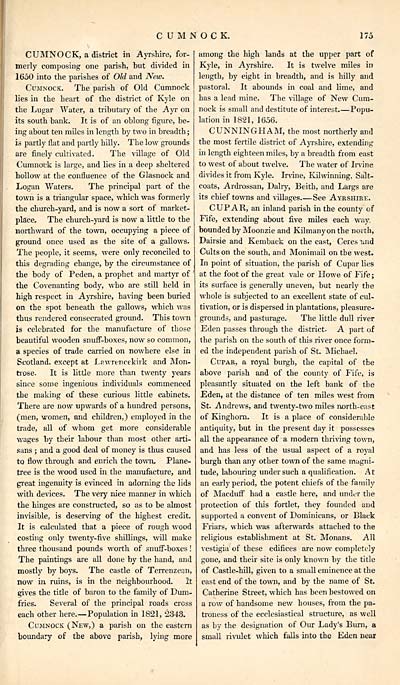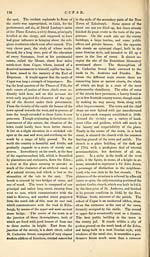Gazetteer of Scotland > Volume 1
(203) Page 175
Download files
Complete book:
Individual page:
Thumbnail gallery: Grid view | List view

CUMNOCK.
175
CUMNOCK, a district in Ayrshire, for-
merly composing one parish, hut divided in
1650 into the parishes of Old and New.
Cumnock. The parish of Old Cumnock
lies in the heart of the district of Kyle on
the Lugar Water, a tributary of the Ayr on
its south bank. It is of an oblong figure, be-
ing about ten miles in length by two in breadth;
is partly flat and partly hilly. The low grounds
are finely cultivated. The village of Old
Cumnock is large, and lies in a deep sheltered
hollow at the confluence of the Glasnock and
Logan "Waters. The principal part of the
town is a triangular space, which was formerly
the church-yard, and is now a sort of market-
place. The church-yard is now a little to the
northward of the town, occupying a piece of
ground once used as the site of a gallows.
The people, it seems, were only reconciled to
this degrading change, by the circumstance of
the body of Peden, a prophet and martyr of
the Covenanting body, who are still held in
high respect in Ayrshire, having been buried
on the spot beneath the gallows, which was
thus rendered consecrated ground. This town
is celebrated for the manufacture of those
beautiful wooden snuff-boxes, now so common,
a species of trade carried on nowhere else in
Scotland, except at Lawrencekirk and Mon-
trose. It is little more than twenty years
since some ingenious individuals commenced
the making of these curious little cabinets.
There are now upwards of a hundred persons,
(men, women, and children,) employed in the
trade, all of whom get more considerable
wages by their labour than most other arti-
sans ; and a good deal of money is thus caused
to flow through and enrich the town. Plane-
tree is the wood used in the manufacture, and
great ingenuity is evinced in adorning the lids
with devices. The veiy nice manner in which
the hinges are constructed, so as to be almost
invisible, is deserving of the highest credit.
It is calculated that a piece of rough wood
costing only twenty-five shillings, will make
three thousand pounds worth of snuff-boxes !
The paintings are all done by the hand, and
mostly by boys. The castle of Terrenzean,
now in ruins, is in the neighbourhood. It
gives the title of baron to the family of Dum-
fries. Several of the principal roads cress
each other here.— Population in 1821, 2343.
Cumnock (New,) a parish on the eastern
boundary of the above parish, lying more
among the high lands at the upper part of
Kyle, in Ayrshire. It is twelve miles in
length, by eight in breadth, and is hilly and
pastoral. It abounds in coal and lime, and
has a lead mine. The village of New Cum-
nock is small and destitute of interest. — Popu-
lation in 1821, 1656.
CUNNINGHAM, the most northerly and
the most fertile district of Ayrshire, extending
in length eighteen miles, by a breadth from east
to west of about twelve. The water of Irvine
divides it from Kyle. Irvine, Kilwinning, Salt-
coats, Ardrossan, Dairy, Beith, and Largs are
its chief towns and villages See Ayrshire.
CUPAR, an inland parish in the county of
Fife, extending about five miles each way;
bounded by Moonzie and Kilmany on the north,
Dairsie and Kemback on the east, Ceres and
Cults on the south, and Monimail on the west.
In point of situation, the parish of Cupar lies
at the foot of the great vale or Howe of Fife ;
its surface is generally uneven, but nearly the
whole is subjected to an excellent state of cul-
tivation, or is dispersed in plantations, pleasure-
grounds, and pasturage. The little dull river
Eden passes through the district. A part of
the parish on the south of this river once form-
ed the independent parish of St. Michael.
Cupar, a royal burgh, the capital of the
above parish and of the county of Fife, is
pleasantly situated on the left bank of the
Eden, at the distance of ten miles west from
St. Andrews, and twenty-two miles north-east
of Kinghorn. It is a place of considerable
antiquity, but in the present day it possesses
all the appearance of a modern thriving town,
and has less of the usual aspect of a royal
burgh than any other town of the same magni-
tude, labouring under such a qualification. At
an early period, the potent chiefs of the family
of Macduff had a castle here, and under the
protection of this fortlet, they founded and
supported a convent of Dominicans, or Black
Friars, which was afterwards attached to the
religious establishment at St. Monans. All
vestigia of these edifices are now completely
gone, and their site is only known by the title
of Castle-hill, given to a small eminence at the
east end of the town, and by the name of St.
Catherine Street, which has been bestowed on
a row of handsome new houses, from the pa-
troness of the ecclesiastical structure, as well
as by the designation of Our Lady's Burn, a
small rivulet which falls into the Eden near
175
CUMNOCK, a district in Ayrshire, for-
merly composing one parish, hut divided in
1650 into the parishes of Old and New.
Cumnock. The parish of Old Cumnock
lies in the heart of the district of Kyle on
the Lugar Water, a tributary of the Ayr on
its south bank. It is of an oblong figure, be-
ing about ten miles in length by two in breadth;
is partly flat and partly hilly. The low grounds
are finely cultivated. The village of Old
Cumnock is large, and lies in a deep sheltered
hollow at the confluence of the Glasnock and
Logan "Waters. The principal part of the
town is a triangular space, which was formerly
the church-yard, and is now a sort of market-
place. The church-yard is now a little to the
northward of the town, occupying a piece of
ground once used as the site of a gallows.
The people, it seems, were only reconciled to
this degrading change, by the circumstance of
the body of Peden, a prophet and martyr of
the Covenanting body, who are still held in
high respect in Ayrshire, having been buried
on the spot beneath the gallows, which was
thus rendered consecrated ground. This town
is celebrated for the manufacture of those
beautiful wooden snuff-boxes, now so common,
a species of trade carried on nowhere else in
Scotland, except at Lawrencekirk and Mon-
trose. It is little more than twenty years
since some ingenious individuals commenced
the making of these curious little cabinets.
There are now upwards of a hundred persons,
(men, women, and children,) employed in the
trade, all of whom get more considerable
wages by their labour than most other arti-
sans ; and a good deal of money is thus caused
to flow through and enrich the town. Plane-
tree is the wood used in the manufacture, and
great ingenuity is evinced in adorning the lids
with devices. The veiy nice manner in which
the hinges are constructed, so as to be almost
invisible, is deserving of the highest credit.
It is calculated that a piece of rough wood
costing only twenty-five shillings, will make
three thousand pounds worth of snuff-boxes !
The paintings are all done by the hand, and
mostly by boys. The castle of Terrenzean,
now in ruins, is in the neighbourhood. It
gives the title of baron to the family of Dum-
fries. Several of the principal roads cress
each other here.— Population in 1821, 2343.
Cumnock (New,) a parish on the eastern
boundary of the above parish, lying more
among the high lands at the upper part of
Kyle, in Ayrshire. It is twelve miles in
length, by eight in breadth, and is hilly and
pastoral. It abounds in coal and lime, and
has a lead mine. The village of New Cum-
nock is small and destitute of interest. — Popu-
lation in 1821, 1656.
CUNNINGHAM, the most northerly and
the most fertile district of Ayrshire, extending
in length eighteen miles, by a breadth from east
to west of about twelve. The water of Irvine
divides it from Kyle. Irvine, Kilwinning, Salt-
coats, Ardrossan, Dairy, Beith, and Largs are
its chief towns and villages See Ayrshire.
CUPAR, an inland parish in the county of
Fife, extending about five miles each way;
bounded by Moonzie and Kilmany on the north,
Dairsie and Kemback on the east, Ceres and
Cults on the south, and Monimail on the west.
In point of situation, the parish of Cupar lies
at the foot of the great vale or Howe of Fife ;
its surface is generally uneven, but nearly the
whole is subjected to an excellent state of cul-
tivation, or is dispersed in plantations, pleasure-
grounds, and pasturage. The little dull river
Eden passes through the district. A part of
the parish on the south of this river once form-
ed the independent parish of St. Michael.
Cupar, a royal burgh, the capital of the
above parish and of the county of Fife, is
pleasantly situated on the left bank of the
Eden, at the distance of ten miles west from
St. Andrews, and twenty-two miles north-east
of Kinghorn. It is a place of considerable
antiquity, but in the present day it possesses
all the appearance of a modern thriving town,
and has less of the usual aspect of a royal
burgh than any other town of the same magni-
tude, labouring under such a qualification. At
an early period, the potent chiefs of the family
of Macduff had a castle here, and under the
protection of this fortlet, they founded and
supported a convent of Dominicans, or Black
Friars, which was afterwards attached to the
religious establishment at St. Monans. All
vestigia of these edifices are now completely
gone, and their site is only known by the title
of Castle-hill, given to a small eminence at the
east end of the town, and by the name of St.
Catherine Street, which has been bestowed on
a row of handsome new houses, from the pa-
troness of the ecclesiastical structure, as well
as by the designation of Our Lady's Burn, a
small rivulet which falls into the Eden near
Set display mode to: Large image | Transcription
Images and transcriptions on this page, including medium image downloads, may be used under the Creative Commons Attribution 4.0 International Licence unless otherwise stated. ![]()
| Gazetteers of Scotland, 1803-1901 > Gazetteer of Scotland > Volume 1 > (203) Page 175 |
|---|
| Permanent URL | https://digital.nls.uk/97426798 |
|---|
| Description | Volume I: Abbey to Glenartney. |
|---|---|
| Attribution and copyright: |
|
| Description | By Robert Chambers and William Chambers. Glasgow: Blackie & Son, 1838. 2 volumes. |
|---|---|
| Shelfmark | NF.1461.g.7 |
| Additional NLS resources: | |

